Presbyterianism

| Part ofa serieson |
| Reformed Christianity |
|---|
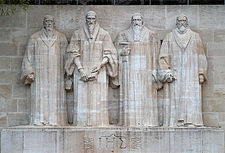 |
|
|
Presbyterianismis aReformed(Calvinist)Protestanttradition named for its form ofchurch governmentby representative assemblies ofelders.[2]Though there are other Reformed churches that are structurally similar, the wordPresbyterianis applied to churches that trace their roots to theChurch of Scotlandor toEnglish Dissenter groupsthat formed during theEnglish Civil War.[3]
Presbyterian theology typically emphasizes thesovereignty of God,theauthority of the Scriptures,and the necessity ofgracethroughfaithin Christ. Presbyterian church government was ensured in Scotland by theActs of Unionin 1707,[4]which created theKingdom of Great Britain.In fact, most Presbyterians found in England can trace aScottishconnection, and the Presbyterian denomination was also taken toNorth America,mostly byScotsandScots-Irishimmigrants. The Presbyterian denominations in Scotland hold to theReformed theologyofJohn Calvinand his immediate successors, although there is a range of theological views within contemporary Presbyterianism. Local congregations of churches which usePresbyterian polityare governed bysessionsmade up of representatives of the congregation (elders), aconciliarapproach as with other levels of decision-making (presbytery,synod,andgeneral assembly). There are roughly 75 million Presbyterians in the world.[5]
The roots of Presbyterianism lie in theReformationof the 16th century, the example of John Calvin'sRepublic of Genevabeing particularly influential. Most Reformed churches that trace their history back to Scotland are either presbyterian orcongregationalistin government. In the 20th century, some Presbyterians played an important role in theecumenical movement,including theWorld Council of Churches.Many Presbyterian denominations have found ways of working together with other Reformed denominations and Christians of other traditions, especially in theWorld Communion of Reformed Churches.Some Presbyterian churches have entered intounionswith other churches, such asCongregationalists,Lutherans,Anglicans,andMethodists.Presbyterians in the United States came largely fromScottish,Scots-Irish immigrants,and also fromNew Englandcommunities that had originally beenCongregationalbut changed because of an agreed-uponPlan of Union of 1801for frontier areas.[6]
Presbyterian identity
[edit]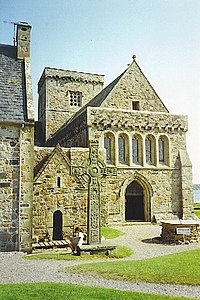
Early history
[edit]Presbyterian tradition, particularly that of theChurch of Scotland,traces its early roots to the Christian Church founded bySaint Columba,through the 6th centuryHiberno-Scottish mission.[7][8][9]Tracing their apostolic origin toSaint John,[10][11]theCuldeespracticedChristian monasticism,a key feature ofCeltic Christianityin the region, with apresbyterexercising "authority within the institution, while the different monastic institutions were independent of one another."[12][7][13]The Church in Scotland kept the Christian feast of Easter at a date different from theSee of Romeand its monks used a unique style oftonsure.[14]TheSynod of Whitbyin 664, however, ended these distinctions as it ruled "that Easter would be celebrated according to the Roman date, not the Celtic date."[15]Although Roman influence came to dominate the Church in Scotland,[15]certain Celtic influences remained in the Scottish Church,[16]such as "the singing ofmetrical psalms,many of them set to old Celtic Christianity Scottish traditional and folk tunes ", which later became a" distinctive part of Scottish Presbyterian worship ".[17][18]
Development
[edit]
Presbyterian history is part of thehistory of Christianity,but the beginning of Presbyterianism as a distinct movement occurred during the 16th centuryProtestant Reformation.As theCatholic Churchresisted the Reformers, several different theological movements splintered from the Church and bore different denominations.
Presbyterianism was especially influenced by the French theologianJohn Calvin,who is credited with the development ofReformed theology,and the work ofJohn Knox,a Scottish Catholic Priest who studied with Calvin in Geneva and brought back Reformed teachings to Scotland. An important influence on the formation of presbyterianism in Britain also came fromJohn a Lasco,a Polish reformer, the founder of aStranger's Churchin London, based on the Geneva models.[19]
The Presbyterian church traces its ancestry back primarily to Scotland. In August 1560, theParliament of Scotlandadopted theScots Confessionas the creed of the Scottish Kingdom. In December 1560, theFirst Book of Disciplinewas published, outlining important doctrinal issues but also establishing regulations for church government, including the creation of ten ecclesiastical districts with appointed superintendents which later became known aspresbyteries.[20]
In time, the Scots Confession would be supplanted by theWestminster Confession of Faith,and thelargerandshorter catechisms,which were formulated by theWestminster Assemblybetween 1643 and 1649.
Characteristics
[edit]Presbyterians distinguish themselves from other denominations bydoctrine,institutional organisation (or "church order" ) andworship,often using a "Book of Order" to regulate common practice and order. The origins of the Presbyterian churches are inCalvinism.Many branches of Presbyterianism are remnants of previous splits from larger groups. Some of the splits have been due to doctrinal controversy, while some have been caused by disagreement concerning the degree to which those ordained to church office should be required to agree with theWestminster Confession of Faith,which historically serves as an important confessional document – second only to the Bible, yet directing particularities in the standardisation and translation of the Bible – in Presbyterian churches.
Presbyterians place great importance upon education and lifelong learning, tempered with the belief that no human action can affectsalvation.
Continuous study of the scriptures, theological writings, and understanding and interpretation of church doctrine are embodied in several statements of faith andcatechismsformally adopted by various branches of the church, often referred to as "subordinate standards".
Government
[edit]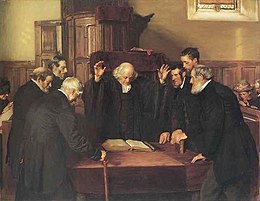
Presbyterian government is by councils (still known ascourtsin some countries, asboardsin others) of elders. Teaching and ruling elders are ordained and convene in the lowest council known as asessionorconsistoryresponsible for the discipline, nurture, and mission of the localcongregation.Teaching elders (pastors or ministers) have responsibility for teaching, worship, and performing sacraments. Pastors or ministers are called by individual congregations. A congregation issues a call for the pastor or minister's service, but this call must be ratified by the local presbytery. The pastor or minister is a teaching elder, and Moderator of the Session, but is not usually a member of the congregation; instead, this person is a member of the Presbytery of which the given church is a member.
Ruling elders are elected by the congregation and ordained to serve with the teaching elders, assuming responsibility for the nurture and leadership of the congregation. Often, especially in larger congregations, the elders delegate the practicalities of buildings, finance, and temporal ministry to the needy in the congregation to a distinct group of officers (sometimes called deacons, which are ordained in some denominations). This group may variously be known as a "Deacon Board", "Board of Deacons" "Diaconate", or "Deacons' Court". These are sometimes known as "presbyters" to the full congregation. Since the 20th century, most denominations allow women to be teaching or ruling elders.
Above the sessions exist presbyteries, which have area responsibilities. These are composed of teaching elders and ruling elders from each of the constituent congregations. The presbytery sends representatives to a broader regional or national assembly, generally known as theGeneral Assembly,although an intermediate level of asynodsometimes exists. This congregation /presbytery/synod/general assemblyschema is based on the historical structure of the larger Presbyterian churches, such as theChurch of Scotlandor thePresbyterian Church (U.S.A.);some bodies, such as thePresbyterian Church in Americaand thePresbyterian Church in Ireland,skip one of the steps between congregation and General Assembly, and usually the step skipped is the Synod. TheChurch of Scotlandabolished the Synod in 1993.[21]
Presbyterian governance is practiced by Presbyterian denominations and also by many otherReformed churches.[22]
Doctrine
[edit]This sectionpossibly containsoriginal research.(September 2014) |
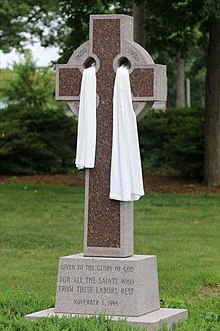


Presbyterianism is historically a confessional tradition. This has two implications. The obvious one is that confessional churches express their faith in the form of "confessions of faith", which have some level of authoritative status. However this is based on a more subtle point: In confessional churches, theology is not solely an individual matter. While individuals are encouraged to understand Scripture, and may challenge the current institutional understanding, theology is carried out by the community as a whole. It is this community understanding of theology that is expressed in confessions.[24]
However, there has arisen a spectrum of approaches toconfessionalism.The manner ofsubscription,or the degree to which the official standards establish the actual doctrine of the church, is a practical matter. That is, the decisions rendered in ordination and in the courts of the church largely determine what the church means, representing the whole, by its adherence to the doctrinal standard.
Some Presbyterian traditions adopt only theWestminster Confession of Faithas the doctrinal standard to which teaching elders are required to subscribe, in contrast to theLargerandShortercatechisms, which are approved for use in instruction. Many Presbyterian denominations, especially in North America, have adopted all of theWestminster Standardsas their standard of doctrine which is subordinate to the Bible. These documents areCalvinisticin their doctrinal orientation. ThePresbyterian Church in Canadaretains the Westminster Confession of Faith in its original form, while admitting the historical period in which it was written should be understood when it is read.
The Westminster Confession is "The principalsubordinate standardof theChurch of Scotland"but" with due regard to liberty of opinion in points which do not enter into the substance of the Faith "(V). This formulation represents many years of struggle over the extent to which the confession reflects the Word of God and the struggle of conscience of those who came to believe it did not fully do so (e.g.William Robertson Smith). Some Presbyterian Churches, such as theFree Church of Scotland,have no such "conscienceclause ".
ThePresbyterian Church (U.S.A.)has adopted theBook of Confessions,which reflects the inclusion of otherReformed confessionsin addition to the Westminster Standards. These other documents include ancient creedal statements (theNicene Creed,theApostles' Creed), 16th-century Reformed confessions (theScots Confession,theHeidelberg Catechism,theSecond Helvetic Confession), and 20th century documents (The Theological Declaration of Barmen,Confession of 1967andA Brief Statement of Faith).
The Presbyterian Church in Canada developed the confessional documentLiving Faith(1984) and retains it as a subordinate standard of the denomination. It is confessional in format, yet like the Westminster Confession, draws attention back to original Bible text.
Presbyterians in Ireland who rejected Calvinism and the Westminster Confessions formed theNon-subscribing Presbyterian Church of Ireland.
John Gresham Machen, the prominent Presbyterian theologian and Professor ofNew TestamentatPrinceton Seminarybetween 1906 and 1929, led a revolt against modernist doctrine in hisChristianity and Liberalism(1923) that critiqued theological modernism. He argued that modernism and liberal theology was a false religion, a pretender that cloaks itself in Christian language – "Liberalism". This religion is a marriage of naturalism, humanism, secularism, and sentimentalism all rolled into one.
Worship and sacraments
[edit]Worship
[edit]Presbyterian denominations that trace their heritage to the British Isles usually organise their church services inspired by the principles in theDirectory of Public Worship,developed by theWestminster Assemblyin the 1640s. This directory documentedReformed worshippractices and theology adopted and developed over the preceding century by BritishPuritans,initially guided by John Calvin and John Knox. It was enacted as law by theScottish Parliament,and became one of the foundational documents of Presbyterian church legislation elsewhere.

Historically, the driving principle in the development of the standards of Presbyterian worship is theRegulative principle of worship,which specifies that (in worship), what is not commanded is forbidden.[25]
Over subsequent centuries, many Presbyterian churches modified these prescriptions by introducing hymnody, instrumental accompaniment, and ceremonialvestmentsinto worship. However, there is not one fixed "Presbyterian" worship style. Although there are set services for theLord's Dayin keeping withfirst-day Sabbatarianism,[26]one can find a service to be evangelical and even revivalist in tone (especially in some conservative denominations), or strongly liturgical, approximating the practices ofLutheranismor more ofAnglicanism(especially where Scottish tradition is esteemed),[clarification needed]or semi-formal, allowing for a balance of hymns, preaching, and congregational participation (favored by many American Presbyterians). Most Presbyterian churches follow the traditional liturgical year and observe the traditional holidays, holy seasons, such asAdvent,Christmas,Ash Wednesday,Holy Week,Easter,Pentecost,etc. They also make use of the appropriateseasonal liturgical colors,etc. Many incorporate ancient liturgical prayers and responses into the communion services and follow a daily, seasonal, and festival lectionary. Other Presbyterians, however, such as theReformed Presbyterians,would practicea cappellaexclusive psalmody,as well as eschew the celebration of holy days.
Among thepaleo-orthodoxandemerging churchmovements in Protestant and evangelical churches, in which some Presbyterians are involved, clergy are moving away from the traditional blackGeneva gownto such vestments as thealbandchasuble,but alsocassockandsurplice(typically a full-length Old English style surplice which resembles theCelticalb, an ungirdled liturgical tunic of the oldGallican Rite), which some, particularly those identifying with the Liturgical Renewal Movement, hold to be more ancient and representative of a more ecumenical past.

Sacraments
[edit]Presbyterians traditionally have held the Worship position that there are only twosacraments:
- Baptism,in which theybaptize infants,as well as unbaptized adults by theAspersion(sprinkling) orAffusion(pouring) method in the name of the Father and of the Son and of the Holy Spirit, rather than theImmersionmethod.
- TheLord's Supper(also known as Communion), in which Presbyterians believe in the Real Presence of Christ (pneumatic presence) in the spiritual sense, in the bread and wine through the Holy Spirit, as opposed to being locally present as intransubstantiationorconsubstantiation.
Architecture
[edit]This sectionneeds additional citations forverification.(January 2024) |
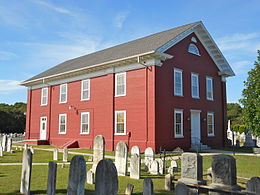
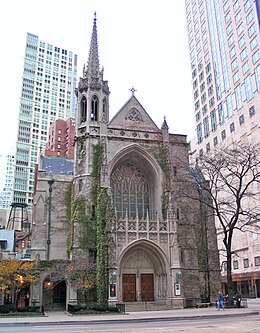
Some early Presbyterians, which were influenced by the puritan movement, were careful to distinguish between the "church", which referred to themembers,and the "meeting house", which was the building in which the church met. (Quakers still insist upon this distinction.) Until the late 19th century, very few Presbyterians ever referred to their buildings as "churches". Presbyterians believed that meeting-houses (now called churches) are buildings to support the worship of God. Thedecorin some instances was austere so as not to detract from worship. Early Presbyterian meeting-houses were extremely plain. No stained glass, no elaborate furnishings, and no images were to be found in the meeting-house. The pulpit, often raised so as only to be accessible by a staircase, was the centerpiece of the building. But these were not the standard characteristics of the mainline Presbyterians. These were more of the wave of Presbyterians that were influenced by the Puritans.
In the late 19th century a gradual shift began to occur. Prosperous congregations built imposing churches, such asFourth Presbyterian Church of Chicago,Brick Presbyterian Churchin New York City,Shadyside Presbyterian Churchin Pennsylvania, St Stephen Presbyterian in Fort Worth, Texas, and many others.
While Presbyterian churches historically reflected prevailing architectural trends, the 20th century saw a greater embrace of modern architectural styles, particularly themodernist movementcharacterized by clean lines, geometric shapes, and open floor plans.[27]Prominent examples includeCoral Ridge Presbyterian Churchin Fort Lauderdale, Florida, with expansive, light-filled sanctuary and angular design elements. Similarly, theNational Presbyterian Churchin Washington, D.C., features a striking facade clad in limestone and punctuated by large windows, alongside abstract stained-glass windows. Both of these were designed by famed architectHarold E. Wagoner.

Usually a Presbyterian church will not have statues of saints, nor the ornate altar more typical of aCatholicchurch. Instead, there is a "communion table", usually on the same level as the congregation, and sometimes elevated similar to an altar, however surrounded by the chancel. There may be a rail between the communion table and the chancel behind it, which may contain a more decorative altar-type table, choir loft, or choir stalls, lectern and clergy area. The altar is called the communion table, and the altar area is called the chancel by Presbyterians. In Presbyterian, and in Reformed churches, there may be an altar cross, either on the communion table or on a table in the chancel. By using the "empty" cross, or cross of the Westminster/Celtic cross, Presbyterians emphasize the resurrection and that Christ is not continually dying, but died once and is alive for all eternity. Quite a few Presbyterian church buildings are decorated with a cross, that has a circle around the center, or Celtic cross. This not only emphasizes the resurrection, but also acknowledges historical aspects of Presbyterianism. A baptismal font will be located either at the entrance or near the chancel area. Presbyterian architecture generally makes significant use of symbolism. One may also find decorative and ornate stained glass windows depicting scenes from the Bible. Some Presbyterian churches will also have ornate statues of Christ or graven scenes from the Last Supper located behind the chancel.St. Giles' Cathedralin Scotland has a crucifix next to an ornate elevated communion table that hangs alongside. The image of Christ is more of a faint image, with a more modern design.[28]
By region
[edit]Europe
[edit]Scotland
[edit]John Knox(1505–1572), aScotwho had spent time studying underCalvinin Geneva, returned toScotlandand urged his countrymen to reform the Church in line withCalvinistdoctrines. After a period of religious convulsion and political conflict culminating in a victory for theProtestant partyat theSiege of Leiththe authority of theCatholic Churchwas abolished in favour ofReformationby the legislation of theScottish Reformation Parliamentin 1560. The Church was eventually organised byAndrew Melvillealong Presbyterian lines to become the nationalChurch of Scotland.King James VI and Imoved the Church of Scotland towards an episcopal form of government, and in 1637, James' successor,Charles IandWilliam Laud,theArchbishop of Canterbury,attempted to force the Church of Scotland to use theBook of Common Prayer.What resulted was an armed insurrection, with many Scots signing theSolemn League and Covenant.TheCovenanterswould serve as the government of Scotland for nearly a decade, and would also send military support to theParliamentariansduring theEnglish Civil War.Following the restoration of the monarchy in 1660,Charles II,despite the initial support that he received from the Covenanters, reinstated an episcopal form of government on the church.

However, with theGlorious Revolutionof 1688 the Church of Scotland was unequivocally recognised as a Presbyterian institution by the monarch due to Scottish Presbyterian support for the aforementioned revolution and theActs of Union 1707between Scotland and England guaranteed the Church of Scotland's form of government. However, legislation by theUnited Kingdom parliamentallowingpatronageled to splits in the Church. In 1733, a group of ministersseceded from the Church of Scotlandto form the Associate Presbytery, another group seceded in 1761 to form theRelief Churchand theDisruption of 1843led to the formation of theFree Church of Scotland.Further splits took place, especially over theological issues, but most Presbyterians in Scotland were reunited by 1929 union of the established Church of Scotland and theUnited Free Church of Scotland.
There are now ten Presbyterian denominations in Scotland today. These are, listed by number of congregations within Scotland: theChurch of Scotland,theFree Church of Scotland,theUnited Free Church of Scotland,theFree Presbyterian Church of Scotland,theFree Church of Scotland (Continuing),theAssociated Presbyterian Church,theReformed Presbyterian Church of Scotland,the 'Didasko Presbytery',[29]theInternational Presbyterian Churchand two congregations of theFree Presbyterian Church of Ulster.Combined, they have over 1500 congregations in Scotland.
Within Scotland the term 'kirk' is usually used to refer to a local Presbyterian church. Informally, the term 'The Kirk' refers to the Church of Scotland. Some of the values and ideals espoused in Scottish Presbyterian denominations can be reflected in this reference in a book from Norman Drummond, chaplain to the Queen in Scotland.[30]
Chart of splits and mergers of the Scottish Presbyterian churches
| Splits and mergers of the Scottish Presbyterian churches | |||||||||||||||||||||||||||||||||||||||||||||||||||||||||||||||||||||||||||||||||||||||||||||||||||||||||||||||||||||||||||||||||||||||||||||||||||||||||||||||||||||||||||||||||||||||||||||||||||||||||||||||||||||||||||||||||||||||||||||||||||||||||||||||||||||||||||||||||||||||||||||||||||||||||||||||||||||||||||||||||||||||||||||||||||||||||||||||||||||||||||||||||||||||||||||||||||||||||||||||||||||||||||||||||||||||||||||||||||||||||||||||||||||||||||||||||||||||||||||||||||||||||||||||||||||||||||||||||||||||||||||||||||||||||||||||||||||||||||||||||||||||||||||||||||||||||||||||||||||||||||||||||||||||||||||||||||||||||||||||||||||||||||||||||||||||||||||||||||||||||||||||||||||||||||||||||||||||||||||||||||||||||||||||||||||||||||||||||||||||||||||||||||||||||||||||||||||||||||||||||||||||||||||||||||||||||||||||||||||||||||||||||||||||||||||||||||||||||||||||||||||||||||||||||||||||||||||||||||||||||||||||||||||||||||||||||||||||||||||||||||||||||||||||||||||||||||||||||||||||
|---|---|---|---|---|---|---|---|---|---|---|---|---|---|---|---|---|---|---|---|---|---|---|---|---|---|---|---|---|---|---|---|---|---|---|---|---|---|---|---|---|---|---|---|---|---|---|---|---|---|---|---|---|---|---|---|---|---|---|---|---|---|---|---|---|---|---|---|---|---|---|---|---|---|---|---|---|---|---|---|---|---|---|---|---|---|---|---|---|---|---|---|---|---|---|---|---|---|---|---|---|---|---|---|---|---|---|---|---|---|---|---|---|---|---|---|---|---|---|---|---|---|---|---|---|---|---|---|---|---|---|---|---|---|---|---|---|---|---|---|---|---|---|---|---|---|---|---|---|---|---|---|---|---|---|---|---|---|---|---|---|---|---|---|---|---|---|---|---|---|---|---|---|---|---|---|---|---|---|---|---|---|---|---|---|---|---|---|---|---|---|---|---|---|---|---|---|---|---|---|---|---|---|---|---|---|---|---|---|---|---|---|---|---|---|---|---|---|---|---|---|---|---|---|---|---|---|---|---|---|---|---|---|---|---|---|---|---|---|---|---|---|---|---|---|---|---|---|---|---|---|---|---|---|---|---|---|---|---|---|---|---|---|---|---|---|---|---|---|---|---|---|---|---|---|---|---|---|---|---|---|---|---|---|---|---|---|---|---|---|---|---|---|---|---|---|---|---|---|---|---|---|---|---|---|---|---|---|---|---|---|---|---|---|---|---|---|---|---|---|---|---|---|---|---|---|---|---|---|---|---|---|---|---|---|---|---|---|---|---|---|---|---|---|---|---|---|---|---|---|---|---|---|---|---|---|---|---|---|---|---|---|---|---|---|---|---|---|---|---|---|---|---|---|---|---|---|---|---|---|---|---|---|---|---|---|---|---|---|---|---|---|---|---|---|---|---|---|---|---|---|---|---|---|---|---|---|---|---|---|---|---|---|---|---|---|---|---|---|---|---|---|---|---|---|---|---|---|---|---|---|---|---|---|---|---|---|---|---|---|---|---|---|---|---|---|---|---|---|---|---|---|---|---|---|---|---|---|---|---|---|---|---|---|---|---|---|---|---|---|---|---|---|---|---|---|---|---|---|---|---|---|---|---|---|---|---|---|---|---|---|---|---|---|---|---|---|---|---|---|---|---|---|---|---|---|---|---|---|---|---|---|---|---|---|---|---|---|---|---|---|---|---|---|---|---|---|---|---|---|---|---|---|---|---|---|---|---|---|---|---|---|---|---|---|---|---|---|---|---|---|---|---|---|---|---|---|---|---|---|---|---|---|---|---|---|---|---|---|---|---|---|---|---|---|---|---|---|---|---|---|---|---|---|---|---|---|---|---|---|---|---|---|---|---|---|---|---|---|---|---|---|---|---|---|---|---|---|---|---|---|---|---|---|---|---|---|---|---|---|---|---|---|---|---|---|---|---|---|---|---|---|---|---|---|---|---|---|---|---|---|---|---|---|---|---|---|---|---|---|---|---|---|---|---|---|---|---|---|---|---|---|---|---|---|---|---|---|---|---|---|---|---|---|---|---|---|---|---|---|---|---|---|---|---|---|---|---|---|---|---|---|---|---|---|---|---|---|---|---|---|---|---|---|---|---|---|---|---|---|---|---|---|---|---|---|---|---|---|---|---|---|---|---|---|---|---|---|---|---|---|---|---|---|---|---|---|---|---|---|---|---|---|---|---|---|---|---|---|---|---|---|---|---|---|---|---|---|---|---|---|---|---|---|---|---|---|---|---|---|---|---|---|---|---|---|---|---|---|---|---|---|---|---|---|---|---|---|---|---|---|---|---|---|---|---|---|---|---|---|---|---|---|---|---|---|---|---|---|---|---|---|---|---|---|---|---|---|---|---|---|---|---|---|---|---|---|---|---|---|---|---|---|---|---|---|---|---|---|---|---|---|---|---|---|---|---|---|---|---|---|---|---|---|---|---|---|---|---|---|---|---|---|---|---|---|---|---|---|---|---|---|---|---|---|---|---|---|---|---|---|---|---|---|---|---|---|---|---|---|---|---|---|---|---|---|---|---|---|---|---|---|---|---|---|---|---|---|---|---|---|---|---|---|---|---|---|---|---|---|---|---|---|---|---|---|---|---|---|---|---|---|---|---|---|---|---|---|---|---|---|---|---|---|---|---|---|---|---|---|---|---|---|---|---|---|---|---|---|---|---|---|---|---|---|---|---|---|---|---|---|---|---|---|---|---|---|---|---|---|---|---|---|---|---|---|---|---|---|---|---|---|---|---|---|---|---|---|---|---|
| |||||||||||||||||||||||||||||||||||||||||||||||||||||||||||||||||||||||||||||||||||||||||||||||||||||||||||||||||||||||||||||||||||||||||||||||||||||||||||||||||||||||||||||||||||||||||||||||||||||||||||||||||||||||||||||||||||||||||||||||||||||||||||||||||||||||||||||||||||||||||||||||||||||||||||||||||||||||||||||||||||||||||||||||||||||||||||||||||||||||||||||||||||||||||||||||||||||||||||||||||||||||||||||||||||||||||||||||||||||||||||||||||||||||||||||||||||||||||||||||||||||||||||||||||||||||||||||||||||||||||||||||||||||||||||||||||||||||||||||||||||||||||||||||||||||||||||||||||||||||||||||||||||||||||||||||||||||||||||||||||||||||||||||||||||||||||||||||||||||||||||||||||||||||||||||||||||||||||||||||||||||||||||||||||||||||||||||||||||||||||||||||||||||||||||||||||||||||||||||||||||||||||||||||||||||||||||||||||||||||||||||||||||||||||||||||||||||||||||||||||||||||||||||||||||||||||||||||||||||||||||||||||||||||||||||||||||||||||||||||||||||||||||||||||||||||||||||||||||||||
England
[edit]In England, Presbyterianism was established in secret in 1592.Thomas Cartwrightis thought to be the first Presbyterian in England. Cartwright's controversial lectures atCambridge Universitycondemning theepiscopalhierarchy of theElizabethanChurch led to his deprivation of his post by ArchbishopJohn Whitgiftand his emigration abroad. Between 1645 and 1648, a series of ordinances of theLong Parliamentestablished Presbyterianism as the polity of theChurch of England.Presbyterian government was established in London and Lancashire and in a few other places in England, although Presbyterian hostility to theexecutionofCharles Iand the establishment of the republicanCommonwealth of Englandmeant that Parliament never enforced the Presbyterian system in England. TheRestoration of the monarchyin 1660 brought the return ofEpiscopal church governmentin England (and in Scotland for a short time); but the Presbyterian church in England continued in Non-Conformity, outside of the established church. In 1719 a major split, theSalter's Hall controversy,occurred; with the majority siding withnontrinitarianviews.Thomas Bradburypublished several sermons bearing on the controversy, and in 1719, "An answer to the reproaches cast on thedissenting ministerswho subscribed their belief of the Eternal Trinity. "By the 18th century many English Presbyterian congregations had becomeUnitarianin doctrine.
A number of new Presbyterian Churches were founded byScottishimmigrants to England in the 19th century and later. Following the 'Disruption' in 1843 many of those linked to the Church of Scotland eventually joined what became the Presbyterian Church of England in 1876. Some, such as Crown Court (Covent Garden, London), St Andrew's (Stepney, London) andSwallow Street(London), did not join the English denomination, which is why there are Church of Scotland congregations in England such as those atCrown Court,andSt Columba's,Pont Street (Knightsbridge) in London. There is also a congregation in the heart of London's financial district called London City Presbyterian Church that is affiliated with the Free Church of Scotland.[31]The Free Presbyterian Church of Scotland also have a congregation in London,[32]as do the Free Presbyterian Church of Ulster - along with five others in England.[33]
In 1972, the Presbyterian Church of England (PCofE) united with theCongregational Church in England and Walesto form theUnited Reformed Church(URC). Among the congregations the PCofE brought to the URC were Tunley (Lancashire),Aston Tirrold(Oxfordshire) and John Knox Presbyterian Church, Stepney, London (now part ofStepney Meeting HouseURC) – these are among the sole survivors today of the English Presbyterian churches of the 17th century. The URC also has a presence in Scotland, mostly of formerCongregationalistChurches. Two former Presbyterian congregations,St Columba's, Cambridge(founded in 1879), andSt Columba's, Oxford(founded as a chaplaincy by the PCofE and theChurch of Scotlandin 1908 and as a congregation of the PCofE in 1929), continue as congregations of the URC and university chaplaincies of theChurch of Scotland.
In recent years a number of smaller denominations adopting Presbyterian forms of church government have organised in England, including theInternational Presbyterian Churchplanted by evangelical theologianFrancis Schaefferof theL'Abri Fellowshipin the 1970s - now with fifteen English-speaking congregations in England, and 6 Korean-speaking congregations. There is also theEvangelical Presbyterian Church in England and Walesfounded in the North of England in the late 1980s.
Wales
[edit]InWales,Presbyterianism is represented by thePresbyterian Church of Wales,which was originally composed largely ofCalvinistic Methodistswho accepted Calvinist theology rather than theArminianismof the Wesleyan Methodists. They broke off from the Church of England in 1811, ordaining their own ministers. They were originally known as the Calvinist Methodist connexion and in the 1920s it became alternatively known as the Presbyterian Church of Wales.
Ireland
[edit]Presbyterianism (Irish:Preispitéireachas,Ulster Scots:Prisbytairinism) is the largest Protestant denomination inNorthern Irelandand the second largest on the island of Ireland (after theAnglicanChurch of Ireland),[34]and was brought by Scottishplantation settlerstoUlsterwho had been strongly encouraged to emigrate by James VI of Scotland, alsoJames I of Ireland and England.An estimated 100,000 Scottish Presbyterians moved to the northern counties of Ireland between 1607 and theBattle of the Boynein 1690.[citation needed]The Presbytery of Ulster was formed in 1642 separately from the established Anglican Church. Presbyterians, along withCatholicsin Ulster and the rest of Ireland, suffered under the discriminatoryPenal Lawsuntil they were revoked in the early 19th century. Presbyterianism is represented in Ireland by thePresbyterian Church in Ireland,theNon-subscribing Presbyterian Church of Ireland,theFree Presbyterian Church of Ulster,theReformed Presbyterian Church of Irelandand theEvangelical Presbyterian Church.
France
[edit]There is a Church of Scotland (Presbyterian) in central Paris:The Scots Kirk,which is English-speaking, and is attended by many nationalities. It maintains close links with the Church of Scotland in Scotland itself, as well as with theReformed Church of France.
Italy
[edit]The Waldensian Evangelical Church (Chiesa Evangelica Valdese, CEV) is an Italian Protestant denomination. The church was founded in the 12th century, and centuries later, after the Protestant Reformation, it adhered to Calvinist theology and became the Italian branch of the Presbyterian churches. As such, the church is a member of the World Communion of Reformed Churches.
North America
[edit]Even before Presbyterianism spread with immigrants abroad from Scotland, there were divisions in the larger Presbyterian family. Some later rejoined only to separate again. In what some interpret as rueful self-reproach, some Presbyterians refer to the divided Presbyterian churches as the "Split Ps".



United States
[edit]Presbyterianism first officially arrived in Colonial America in 1644 with the establishment of Christ's First Presbyterian Church in Hempstead, New York. The Church was organized by the Rev. Richard Denton.
In 1703 the first Presbytery in Philadelphia was established. In time, the presbytery would be joined by two more to form a synod (1717) and would evolve into thePresbyterian Church in the United States of Americain 1789. The nation's largest Presbyterian denomination, thePresbyterian Church (U.S.A.)– PC (USA) – can trace its heritage back to the original PCUSA, as can thePresbyterian Church in America(PCA), theOrthodox Presbyterian Church(OPC), theBible Presbyterian Church(BPC), theCumberland Presbyterian Church(CPC), theCumberland Presbyterian Church in America,theEvangelical Presbyterian Church(EPC), and theEvangelical Covenant Order of Presbyterians(ECO).
Other Presbyterian bodies in the United States include theReformed Presbyterian Church of North America(RPCNA), theAssociate Reformed Presbyterian Church(ARP), theReformed Presbyterian Church in the United States(RPCUS), theReformed Presbyterian Church General Assembly,theReformed Presbyterian Church – Hanover Presbytery,theCovenant Presbyterian Church,the Presbyterian Reformed Church, the Westminster Presbyterian Church in the United States, theKorean American Presbyterian Church,and theFree Presbyterian Church of North America.
The territory within about a 50-mile (80 km) radius ofCharlotte, North Carolina,is historically the greatest concentration of Presbyterianism in the Southern United States, while an almost identical geographic area aroundPittsburgh,Pennsylvania, contains probably the largest number of Presbyterians in the entire nation.
The PC (USA), beginning with its predecessor bodies, has, in common with other so-called "mainline" Protestant denominations, experienced a significant decline in members in recent years. Some estimates have placed that loss at nearly half in the last forty years.[35]
Presbyterian influence, especially throughPrinceton theology,can be traced in modernEvangelicalism.Balmer says that:
Evangelicalism itself, I believe, is a quintessentially North American phenomenon, deriving as it did from the confluence ofPietism,Presbyterianism, and the vestiges ofPuritanism.Evangelicalism picked up the peculiar characteristics from each strain – warmhearted spirituality from the Pietists (for instance), doctrinal precisionism from the Presbyterians, and individualistic introspection from the Puritans – even as the North American context itself has profoundly shaped the various manifestations of evangelicalism: fundamentalism, neo-evangelicalism, the holiness movement, Pentecostalism, the charismatic movement, and various forms of African-American and Hispanic evangelicalism.[36]
— Randall Balmer, The Encyclopedia of Evangelicalism (2002)
In the late 1800s, Presbyterian missionaries established a presence in what is now northern New Mexico. This provided an alternative to the Catholicism, which was brought to the area by the Spanish Conquistadors and had remained unchanged. The area experienced a "mini" reformation, in that many converts were made to Presbyterianism, prompting persecution. In some cases, the converts left towns and villages to establish their own neighboring villages. The arrival of the United States to the area prompted the Catholic church to modernize and make efforts at winning the converts back, many of which did return. However, there are still stalwart Presbyterians and Presbyterian churches in the area.
Historically, along with Lutherans andEpiscopalians,Presbyterians tend to be considerably wealthier[37]and are better educated (having moregraduateand post-graduate degrees per capita) than most other religious groups in United States;[38]a group known asWhite Anglo-Saxon Protestants(WASPs), they are disproportionately represented in the upper reaches of American business,[39]law, and politics.[40]
Canada
[edit]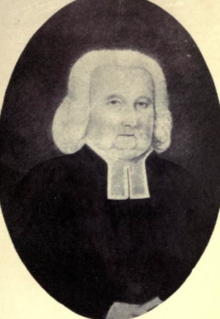
In Canada, the largest Presbyterian denomination – and indeed the largest Protestant denomination – was thePresbyterian Church in Canada,formed in 1875 with the merger of four regional groups. In 1925, theUnited Church of Canadawas formed by the majority of Presbyterians combining with theMethodist Church,Canada, and theCongregational Union of Canada.A sizable minority of Canadian Presbyterians, primarily in southernOntariobut also throughout the entire nation, withdrew, and reconstituted themselves as a non-concurring continuing Presbyterian body. They regained use of the original name in 1939.
Latin America
[edit]
Presbyterianism arrived in Latin America in the 19th century.
Mexico
[edit]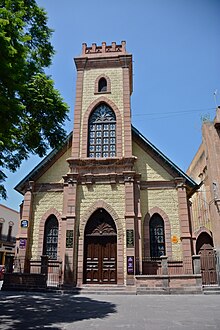
The biggest Presbyterian church is theNational Presbyterian Church in Mexico(Iglesia Nacional Presbiteriana de México), which has around 2,500,000 members and associates and 3000 congregations, but there are other small denominations like the Associate Reformed Presbyterian Church in Mexico which was founded in 1875 by the Associate Reformed Church in North America. The Independent Presbyterian Church, the Presbyterian Reformed Church in Mexico, and the National Conservative Presbyterian Church in Mexico are existing churches in the Reformed tradition.
Brazil
[edit]In Brazil, thePresbyterian Church of Brazil(Igreja Presbiteriana do Brasil) totals approximately 1,011,300 members;[41]other Presbyterian churches (Independents, United, Conservatives, Renovated, etc.) in this nation have around 350,000 members. TheRenewed Presbyterian Church in Brazilwas influenced by the charismatic movement and has about 131 000 members as of 2011.[42]TheConservative Presbyterian Church in Brazilwas founded in 1940 and has eight presbyteries.[43]The Fundamentalist Presbyterian church in Brazil was influenced byCarl McIntireand the USBible Presbyterian Churchand has around 1 800 members. TheIndependent Presbyterian Church of Brazilwas founded in 1903 by Rev. Eduardo Carlos Pereira, has 500 congregations and 75 000 members. TheUnited Presbyterian Church of Brazilhas around 4 000 members. There are also ethnic Korean Presbyterian churches in the country. TheEvangelical Reformed Churches in Brazilhas Dutch origin. TheReformed Churches in Brazilwere recently founded by theCanadian Reformed Churcheswith theReformed Churches in the Netherlands (Liberated).
Congregationalchurches present in the country are also part of the Calvinistic tradition in Latin America.
Other Latin American states
[edit]There are probably more than four million members of Presbyterian churches in all of Latin America. Presbyterian churches are also present in Peru, Bolivia, Cuba, Trinidad and Tobago, Venezuela, Colombia, Chile, Paraguay, Costa Rica, Nicaragua, Argentina, Honduras and others, but with few members. The Presbyterian Church in Belize has 17 churches and church plants and there is a Reformed Seminary founded in 2004. Some Latin Americans in North America are active in thePresbyterian Cursillo Movement.
Africa
[edit]
Presbyterianism arrived in Africa in the 19th century through the work of Scottish missionaries and founded churches such asSt Michael and All Angels Church, Blantyre, Malawi.The church has grown extensively and now has a presence in at least 23 countries in the region.[44]
African Presbyterian churches often incorporate diaconal ministries, including social services, emergency relief, and the operation of mission hospitals. A number of partnerships exist between presbyteries in Africa and the PC(USA), including specific connections with Lesotho, Cameroon, Malawi, South Africa, Ghana and Zambia. For example, the Lackawanna Presbytery, located in Northeastern Pennsylvania, has a partnership with a presbytery in Ghana. Also the Southminster Presbyterian Church, located near Pittsburgh, has partnerships with churches in Malawi and Kenya. The Presbyterian Church of Nigeria, western Africa is also healthy and strong in mostly the southern states of this nation, strong density in the south-eastern states of this country. Beginning from Cross River state, the nearby coastal states, Rivers state, Lagos state to Ebonyi and Abia States.Hope Waddel's missionary expedition in the mid 19th century, and laterMary Slessor's stay in this coastal regions of the then British colony has brought about the beginning and the flourishing of this church in these areas.
Cameroon
ThePresbyterian Church in Camerooncurrently a member of reformed churches in Cameroon
Kenya
[edit]ThePresbyterian Church of East Africa,based in Kenya, is particularly strong, with 500 clergy and 4 million members.[45]
Malawi
[edit]The Reformed Presbyterian Church in Malawi has 150 congregations and 17 000–20 000 members[citation needed].It was a mission of the Free Presbyterian church of Scotland. The Restored Reformed Church works with RPCM. Evangelical Presbyterian Church in Malawi is an existing small church. Part of the Presbyterian Church in Malawi and Zambia is known as CCAP, Church of Central Africa-Presbyterian. Often the churches there have one main congregation and a number of prayer houses develop. Education, health ministries, and worship and spiritual development are important.
Southern Africa
[edit]Southern Africa is a major base of Reformed and Presbyterian Churches.[citation needed]
Northern Africa
[edit]- The Presbyterian Church of South Sudan and Sudan,founded in 1902 by American missionaries inMalakal,was deprived of foreign pastors since 1962 by decision of the Sudanese government but it continued to grow. It is now the 3rd largest Christian church in Sudan with 1,000,000 members, now shared betweenSudanandSouth Sudan.[46]
- ThePresbyterian Evangelical Church of Sudanwas founded in the north of the country and in Khartoum by the same American missionaries in the late 19th century but left under the guidance of Egyptian evangelical pastors of Coptic origin.[46]
In addition, there are a number of Presbyterian Churches in north Africa, the most known is the Nile Synod in Egypt and a recently founded synod for Sudan.
Asia
[edit]Hong Kong
[edit]The Hong Kong Council of the Church of Christ in China(CCC) is a uniting church formed byPresbyteriansandCongregationalists,which inherited theReformed tradition.HKCCCCis also the onlymainlineReformed church in Hong Kong.
Cumberland Presbyterian Church Yao Dao Secondary Schoolis a Presbyterian school inYuen Long,New Territories.TheCumberland Presbyterian Churchalso have a church on the island ofCheung Chau.There are alsoKorean Christiansresident in Hong Kong who are Presbyterians.[citation needed]
South Korea
[edit]Presbyterian Churches are the biggest and by far the most influential Protestant denominations in South Korea, with close to 20,000 churches affiliated with the two largest Presbyterian denominations in the country.[47]In South Korea there are 9 million Presbyterians, forming the majority of the 15 million KoreanProtestants.In South Korea there are 100 different Presbyterian denominations.[48]
Most of the Korean Presbyterian denominations share the same name in Korean, 대한예수교장로회 (literally means the Presbyterian Church of Korea or PCK), tracing its roots to the United Presbyterian Assembly before its long history of disputes and schisms. The Presbyterian schism began with the controversy in relation to the Japanese shrine worship enforced during the Japanese colonial period and the establishment of a minor division (Koryu-pa, 고려파, later The Koshin Presbyterian Church in Korea, Koshin 고신) in 1952. And in 1953 the second schism happened when the theological orientation of the Chosun Seminary (later Hanshin University) founded in 1947 could not be tolerated in the PCK and another minor group (The Presbyterian Church in the Republic of Korea, Kijang, 기장) was separated. The last major schism had to do with the issue of whether the PCK should join the WCC. The controversy divided the PCK into two denominations, The Presbyterian Church of Korea (Tonghap, 통합) and The General Assembly of Presbyterian Church in Korea (Hapdong, 합동) in 1959. All major seminaries associated with each denomination claim heritage from the Pyung Yang Theological Seminary, therefore, not only Presbyterian University and Theological Seminary and Chongsin University which are related to PCK but also Hanshin University of PROK all celebrated the 100th class in 2007, 100 years from the first graduates of Pyung Yang Theological Seminary.[49]
Korean Presbyterian denominations are active in evangelism and many of its missionaries are being sent overseas, being the second biggest missionary sender in the world after the United States. GMS, the missionary body of the "Hapdong" General Assembly of Presbyterian Churches of Korea, is the single largest Presbyterian missionary organization in Korea.[50] In addition there are many Korean-American Presbyterians in the United States, either with their own church sites or sharing space in pre-existing churches as is the case in Australia, New Zealand and even Muslim countries such as Saudi Arabia with Korean immigration.
The Korean Presbyterian Church started through the mission of the Presbyterian Church (USA) and the Australian Presbyterian theological tradition is central to the United States. But after independence, the 'Presbyterian Church in Korea (KoRyuPa)' advocated a DutchReformedposition. In the 21st century, a new General Assembly of the Orthodox Presbyterian Church of Korea (Founder. Ha Seung-moo) in 2012 declared itself an authentic historical succession of Scottish Presbyterian John Knox.
Taiwan
[edit]ThePresbyterian Church in Taiwan(PCT) is by far the largest Protestant denomination inTaiwan,with some 238,372 members as of 2009 (including a majority of the island'saborigines).English Presbyterian MissionaryJames Laidlaw Maxwellestablished the first Presbyterian church inTainanin 1865. His colleagueGeorge Leslie Mackay,of theCanadian Presbyterian Mission,was active inTamsuiand north Taiwan from 1872 to 1901; he founded the island's first university and hospital, and created a written script forTaiwanese Minnan.The English and Canadian missions joined as the PCT in 1912. One of the few churches permitted to operate in Taiwan through the era of Japanese rule (1895–1945), the PCT experienced rapid growth during the era ofKuomintang-imposed martial law (1949–1987), in part due to its support for democracy, human rights, andTaiwan independence.FormerROCpresidentLee Teng-hui(in office 1988–2000) was a Presbyterian.
India
[edit]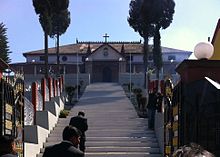
In the mainly Christian Indian state ofMizoram,Presbyterianism is the largest of allChristian denominations.It was brought there bymissionariesfromWalesin 1897. Prior to Mizoram, Welsh Presbyterians started venturing into the northeast India through theKhasi Hills(now in the state ofMeghalayain India) and established Presbyterian churches all over the Khasi Hills from the 1840s onwards. Hence, there is a strong presence of Presbyterians inShillong(the present capital of Meghalaya) and the areas adjoining it. The Welsh missionaries built their first church inSohra(akaCherrapunji) in 1846. The Presbyterian church in India was integrated in 1970 into theUnited Church of Northern India(originally formed in 1924). It is the largest Presbyterian denomination in India.
Oceania
[edit]Australia
[edit]
In Australia, Presbyterianism is the fourth largest denomination of Christianity, with nearly 600,000 Australians claiming to be Presbyterian in the 2006 Commonwealth Census. Presbyterian churches were founded in each colony, some with links to the Church of Scotland and others to the Free Church. There were also congregations originating from United Presbyterian Church of Scotland as well as a number founded byJohn Dunmore Lang.Most of these bodies merged between 1859 and 1870, and in 1901 formed a federal union called thePresbyterian Church of Australiabut retaining their state assemblies. ThePresbyterian Church of Eastern Australiarepresenting the Free Church of Scotland tradition, and congregations in Victoria of theReformed Presbyterian Church,originally from Ireland, are the other existing denominations dating from colonial times.
In 1977, about 70% of the Presbyterian Church of Australia, along with most of theCongregational Union of Australiaand all theMethodist Church of Australasia,combined to form theUniting Church in Australia.[51]The 30% who did not unite had various reasons for so acting, often cultural attachment but often conservative theological or social views. The permission for the ordination of women given in 1974 was rescinded in 1991 without affecting the two or three existing woman ministers[citation needed].The approval of women elders given in the 1960s has been rescinded in all states except New South Wales, which has the largest membership[citation needed].The theology of the church is now generally conservative and Reformed[citation needed].A number of small Presbyterian denominations have arisen since the 1950s through migration or schism.
New Zealand
[edit]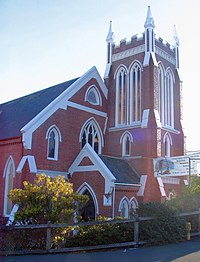
InNew Zealand,Presbyterian is the dominant denomination in Otago and Southland due largely to the richScottishand to a lesser extentUlster-Scotsheritage in the region. The area around Christchurch, Canterbury, is dominated philosophically by theAnglicandenomination.
Originally there were two branches of Presbyterianism in New Zealand, the northern Presbyterian church which existed in the North Island and the parts of the South Island north of theWaitaki River,and theSynod of Otago and Southland,founded byFree Churchsettlers in southern South Island. The two churches merged in 1901, forming what is now thePresbyterian Church of Aotearoa New Zealand.
In addition to the Presbyterian Church of Aotearoa New Zealand, there is also a more conservative Presbyterian church calledGrace Presbyterian Church of New Zealand.Many of its members left the largely liberal PCANZ because they were seeking a more conservative church. It has 17 churches throughout New Zealand.
Vanuatu
[edit]ThePresbyterian Church in Vanuatuis the largest denomination in the country, with approximately one-third of the population of Vanuatu members of the church. The PCV was taken to Vanuatu by missionaries from Scotland. The PCV (Presbyterian Church of Vanuatu) is headed by a moderator with offices inPort Vila.The PCV is particularly strong in the provinces ofTafea,Shefa,andMalampa.The Province ofSanmais mainly Presbyterian with a strong Catholic minority in theFrancophoneareas of the province. There are some Presbyterian people, but no organised Presbyterian churches inPenamaandTorba,both of which are traditionally Anglican. Vanuatu is the only country in the South Pacific with a significant Presbyterian heritage and membership. The PCV is a founding member of theVanuatu Christian Council(VCC). The PCV runs many primary schools and Onesua secondary school. The church is strong in the rural villages.
See also
[edit]- Celtic cross
- English Presbyterianism
- Fundamentalist–Modernist Controversy
- Ghost Ranch
- Puritan's Pit
- Presbyterian confessions of faith
- Religion in Scotland
- Category:Presbyterian universities and colleges
- Category:Presbyterians
Churches
[edit]- List of Christian denominations#Presbyterianism
- List of Presbyterian churches
- St Giles' Cathedral,Edinburgh (Church of Scotland) – famous among Presbyterians worldwide for John Knox's success in preaching there
References
[edit]- ^"Burning Bush | Presbyterian Church Ireland".Archived fromthe originalon 18 June 2013.Retrieved16 June2013.
- ^"What Is Presbyterianism?".Ligonier Ministries.Retrieved27 February2024.
- ^Benedict, Philip(2002).Christ's Churches Purely Reformed: A Social History of Calvinism.New Haven:Yale University Press.p. xiv.ISBN978-0-300-10507-0.
- ^"Protestant Religion and Presbyterian Church Act 1707".The National Archives.United Kingdom.Archivedfrom the original on 21 August 2019.Retrieved19 October2011.
- ^"Who Are Presbyterians and What Do They Believe?".Learn Religions.Archivedfrom the original on 8 July 2020.Retrieved14 September2020.
- ^Mark J Englund-Krieger (2015).The Presbyterian Mission Enterprise: From Heathen to The Partner.Wipf and Stock Publishers. pp. 40–41.ISBN978-1-63087-878-8.Archivedfrom the original on 29 April 2016.Retrieved19 February2016.
- ^abAtkins, Gareth (1 August 2016).Making and Remaking Saints in Nineteenth-Century Britain.Manchester University Press. p. 104.ISBN978-1-5261-0023-8.
For many Presbyterian evangelicals in Scotland, the 'achievements of the Reformation represented the return to a native or national tradition, the rejection of an alien tyranny that had suppressed... Scotland's true character as a Presbyterian nation enjoying the benefits of civil and religious liberty'. What they had in mind was the mission established by Columba at Iona and the subsequent spread of Christianity through the Culdees of the seventh to eleventh centuries. For Presbyterian scholars in the nineteenth century, these communities of clergy who differed in organisation and ethos from later monastic orders were further evidence of the similarity between early Christianity in Ireland and Scotland and later Presbyterianism. This interpretation of the character of the Celtic Church was an important aspect of Presbyterian identity in global terms. At the first meeting in 1877 of the Alliance of the Reformed Churches holding the Presbyterian System (later the World Alliance of Reformed Churches), Peter Lorimer (1812–79), a Presbyterian professor in London, noted 'that the early Church of St. Patrick, Columba, and Columbanus, was far more nearly allied in its fundamental principles of order and discipline to the Presbyterian than to the Episcopalian Churches of modern times'.
- ^Taylor, James; Anderson, John (1852).The Pictorial History of Scotland.p. 51.
The zealous Presbyterian maintains, that the church established by Columba was formed on a Presbyterian model, and that it recognized the great principle of clerical equality.
- ^Bradley, Ian (24 July 2013).Columba.Wild Goose Publications. p. 29.ISBN978-1-84952-272-4.
Columba has found favour with enthusiasts for all things Celtic and with those who have seen him as establishing a proto-Presbyterian church clearly distinguishable from the episcopally governed church favoured by Rome-educated Bishop Ninian.
- ^Dickens-Lewis, W.F. (1920). "Apostolicity of Presbyterianism: Ancient Culdeeism and Modern Presbyterianism".The Presbyterian Magazine.26(1–7).Presbyterian Church (USA):529.
The Culdees who claimed at the Synod of Whitby apostolic descent from St. John, as against the Romish claim of the authority of St. Peter, retired into Scotland.
- ^Thomson, Thomas (1896).A History of the Scottish People from the Earliest Times.Blackie. p.141.
...for the primitive apostolic church which St. John had established in the East and Columba transported to our shores. Thus the days of Culdeeism were numbered, and she was now awaiting the martyrs doom.
- ^Mackay, John; Mackay, Annie Maclean Sharp (1902).The Celtic Monthly.Archibald Sinclair. p. 236.
- ^Hannrachain, T. O'; Armstrong, R.; hAnnracháin, Tadhg Ó (30 July 2014).Christianities in the Early Modern Celtic World.Springer. p. 198.ISBN978-1-137-30635-7.
Presbyterians after 1690 gave yet more play to 'Culdeeism', a reading of the past wherein 'culdees' (derived from céli dé) were presented as upholding a native, collegiate, proto presbyterian church government uncontaminated by bishops.
- ^Rankin, James (1884).The Young Churchman: lessons on the Creed, the Commandments, the means of grace, and the Church.William Blackwood and Sons. p. 84.
For seven whole centuries (400–1100 A.D.) there existed in Scotland a genuine Celtic Church, apparently of Greek origin, and in close connection with both Ireland and Wales. In this Celtic Church no Pope was recognized, and no prelatical of diocesan bishops existed. Their bishops were of the primitive New Testament style—presbyter-bishops. Easter was kept at a different time from that of Rome. The tonsure of the monks was not, like that of Rome, on the crown, but across the forehead from ear to ear. The monastic system of the Celtic Church was extremely simple—small communities of twelve men were presided over by an abbot (kindred to the Patriarch title of the Greeks), who took precedence of the humble parochial bishops.
- ^abSawyers, June Skinner (1999).Maverick Guide to Scotland.Pelican Publishing. p. 57.ISBN978-1-4556-0866-9.
The Celtic Church evolved separated from the Roman Catholic Church. The Celtic Church was primarily monastic, and the monasteries were administered by an abbot. Not as organized as the church in Rome, it was a much looser institution. The Celtic Church celebrated Easter on a different date from the Roman, too. Life within the Celtic Church tended to be ascetic. Education was an important element, as was passion for spreading the word, that is, evangelism. The Celtic brothers led a simple life in simply constructed buildings. The churches and monastic buildings were usually made of wood and wattle and had thatched roofs. After the death of St. Columba in A.D. 597, the autonomy of the Celtic Church did not last long. The Synod of Whitby in 664 decided, once and for all, that Easter would be celebrated according to the Roman date, not the Celtic date. This was the beginning of the end for the Celtic Church.
- ^Eggins, Brian (2 March 2015).History & Hope: The Alliance Party in Northern Ireland.History Press. p. 15.ISBN978-0-7509-6475-3.
After the Synod of Whitby in about 664, the Roman tradition was imposed on the whole Church, though remnants of the Celtic tradition lingered in practice.
- ^Bowden, John Stephen (2005).Encyclopedia of Christianity.Oxford University Press.p. 242.ISBN978-0-19-522393-4.
A distinctive part of Scottish Presbyterian worship is the singing of metrical psalms, many of them set to old Celtic Christianity Scottish traditional and folk tunes. These verse psalms have been exported to Africa, North America and other parts of the world where Presbyterian Scots missionaries or Emigres have been influential.
- ^Hechter, Michael (1995).Internal Colonialism: The Celtic Fringe in British National Development.Transaction Publishers. p. 168.ISBN978-1-4128-2645-7.
Last, because Scotland was a sovereign land in the sixteenth century, the Scottish Reformation came under the influence of John Knox rather than Henry Tudor. The organization of the Church of Scotland became Presbyterian, with significant Calvinist influences, rather than Episcopalian. Upon incorporation Scotland was allowed to keep her church intact. These regional religious differences were to an extent superimposed upon linguistic differences in Wales, Scotland, and Ireland. One of the legacies of the Celtic social organization was the persistence of the Celtic languages Gaelic and Welsh among certain groups in the periphery.
- ^Kang, Min (2011).John Calvin and John a Lasco on Church Order.pp. 6, 44.
- ^"Established Church of Scotland".Catholic Encyclopedia.Archivedfrom the original on 20 November 2018.Retrieved26 September2010.
- ^"Church of Scotland – Historical Records".22 February 2010.Archivedfrom the original on 6 May 2019.Retrieved31 May2016.
- ^Constitution of the Presbyterian Church (USA): Part I: The Book of Confessions, p. 267.
- ^"Available Emblems of Belief for Placement on Government Headstones and Markers".United States Department of Veterans Affairs.Archivedfrom the original on 4 May 2019.Retrieved22 March2015.
- ^D. G. Hart, "The Lost Soul of American Protestantism." Rowman and Littlefield, 2004[page needed]
- ^Westminster Confession of Faith,Chapter XXI, paragraph I
- ^Wigley, John (1980).The Rise and Fall of the Victorian Sunday.Manchester University Press. p. 800.ISBN978-0-7190-0794-1.
Following the formulation of the Westminster Confession, fully fledged Sabbatarianism quickly took root too, being embodied in an Act of 1661, then spreading northwards and westwards as the Highlands were opened up after the '45, during which time the doctrine lost its original force and vigour in the Lowlands.
- ^"What Is Modern Architecture? Everything You Ever Wanted to Know".The Spruce.Retrieved27 February2024.
- ^"Cathedral Life".24 September 2018.Archivedfrom the original on 6 August 2020.Retrieved29 July2020.
- ^"Home".sites.google.Retrieved10 May2024.
- ^Drummond, Norman (2010).The Power of Three: Discovering what really matters in life.London: Hachette (Hodder & Stoughton).ISBN978-0-340-97991-4.
- ^"London City Presbyterian Church".Retrieved10 May2024.
- ^"London Congregation – Free Presbyterian Church of Scotland".fpchurch.org.uk.Retrieved10 May2024.
- ^"Free Presbyterian Church of Ulster - Churches".Retrieved10 May2024.
- ^Kiprop, Victor (16 April 2019)."Religion Demographics Of Northern Ireland".worldatlas.World Facts.Retrieved2 September2021.
- ^"Big Losses Projected",News,Layman, 2006, archived fromthe originalon 5 July 2008.
- ^Balmer, Randall (2002).The Encyclopedia of Evangelicalism.Westminster John Knox Press. pp. vii–viii.ISBN978-0-664-22409-7.Archivedfrom the original on 6 September 2015.Retrieved27 June2015.
- ^Ayres, B. Drummond Jr. (28 April 1981)."The Episcopalians: An American Elite with Roots Going Back to Jamestown".New York Times.Archivedfrom the original on 19 January 2018.Retrieved17 August2012.
- ^Irving Lewis Allen, "WASP—From Sociological Concept to Epithet",Ethnicity,1975 154+
- ^Hacker, Andrew (1957). "Liberal Democracy and Social Control".American Political Science Review.51(4): 1009–1026 [p. 1011].doi:10.2307/1952449.JSTOR1952449.S2CID146933599.
- ^Baltzell (1964).The Protestant Establishment.New York, Random House. p.9.
- ^"Estatísticas 2011 Dados Estimados"(PDF).Executivaipb.br.Archived(PDF)from the original on 24 September 2015.Retrieved30 January2018.
- ^"Igreja Presbiteriana Renovada do Brasil".IPRB. Archived fromthe originalon 1 November 2016.Retrieved25 May2013.
- ^"Igreja Presbiteriana Conservadora do Brasil".IPCB.Archivedfrom the original on 21 May 2013.Retrieved25 May2013.
- ^"Worldwide Ministries, Africa".PC(USA). Archived fromthe originalon 15 August 2013.Retrieved7 December2012.
- ^"Worldwide Ministries, Kenya".PC(USA).Archivedfrom the original on 15 August 2013.Retrieved7 December2012.
- ^ab"Presbyterian Church of South Sudan and Sudan".the website of theWorld Council of Churches.January 1965.Archivedfrom the original on 18 November 2018.Retrieved14 September2018..
- ^"History".KR:The Presbyterian Church of Korea.Archivedfrom the original on 18 July 2011.Retrieved1 August2011..
- ^"Touched by Devotion in South Korea"(article). Christian Reformed Church. 4 October 2010. Archived fromthe originalon 9 July 2017.Retrieved4 September2013..
- ^리폼드뉴스(in Korean). KR: Reformed news. 28 May 2009.Archivedfrom the original on 22 July 2011.Retrieved7 August2011.
- ^Search,KR: KCM,archivedfrom the original on 29 October 2013,retrieved7 August2011.
- ^Rowland Ward and Robert Humphreys,Religious Bodies in Australia,3rd edition (Wantirna, Victoria:New Melbourne Press, 1995), 77.
Sources
[edit]- Stewart J Brown.The National Churches of England, Ireland, and Scotland, 1801–46(2001)
- William the Baptistby James M. Chaney (Reformed Presbyterian perspective on baptism and infant baptism)
- Jay E. Adams.The Meaning and Mode of BaptismThomas Shepard. (1975) (Reformed Presbyterian perspective onAspersionandAffusion)
- The Church Membership of Children, and Their Right to BaptismArchived11 November 2011 at theWayback Machine(1662) (Reformed Presbyterian perspective on infants' right to church membership)
- William Henry Foote.Sketches of North Carolina, Historical and Biographical...(1846)Archived4 February 2008 at theWayback Machine– full-text history of early North Carolina and its Presbyterian churches
- Andrew Lang (1905).John Knox and the Reformation.Longmans, Green, and Company.
- William Klempa, ed.The Burning Bush and a Few Acres of Snow: The Presbyterian Contribution to Canadian Life and Culture(1994)
- Marsden, George M.The Evangelical Mind and the New School Presbyterian Experience(1970)
- Mark A Noll.Princeton And The Republic, 1768–1822(2004)
- Frank Joseph Smith,The History of the Presbyterian Church in America,Reformation Education Foundation, Manassas, VA 1985
- William Warren Sweet,Religion on the American Frontier, 1783—1840, vol. 2, The Presbyterians(1936), primary sources
- Ernest Trice Thompson.Presbyterians in the Southvol 1: to 1860; Vol 2: 1861–1890; Vol 3: 1890–1972. (1963–1973)
- Leonard J. Trinterud,The Forming of an American Tradition: A Re-examination of Colonial Presbyterianism(1949)
- Encyclopedia of the Presbyterian Church in the United States of America(1884)
- St.Andrews Prebystarian church in Lahore, Pakistan.Church WebsiteArchived1 April 2020 at theWayback Machine
- "Presbyterian 101 – Mission and Ministry – GAMC".Pcusa.org. Archived fromthe originalon 2 September 2009.Retrieved7 August2011.
- "History and Architecture:: East Liberty Presbyterian Church, Pittsburgh, PA::" The Cathedral of Hope "".Cathedralofhope.org. Archived fromthe originalon 25 July 2011.Retrieved7 August2011.
Further reading
[edit]- Davies, A. Mervyn (1965).Presbyterian Heritage.
- Feldmeth, Nathan P.; Fortson, S. Donald III; Rosell, Garth M.; Stewart, Kenneth J. (2022).Reformed and Evangelical across Four Centuries: The Presbyterian Story in America.Grand Rapids, MI: Eerdmans.
- Lingle, Walter L.; Kuykendall, John W. (1978).Presbyterians: Their History and Beliefs(4th rev. ed.). Atlanta: Westminster John Knox Press.
- Smylie, James H. (1996).A Brief History of the Presbyterians.Louisville, KY: Geneva Press.ISBN978-0-664-50001-6.
External links
[edit] Media related toPresbyterianismat Wikimedia Commons
Media related toPresbyterianismat Wikimedia Commons- Presbyterian Heritage and History Center
- Presbyterian & Reformed Publishing
